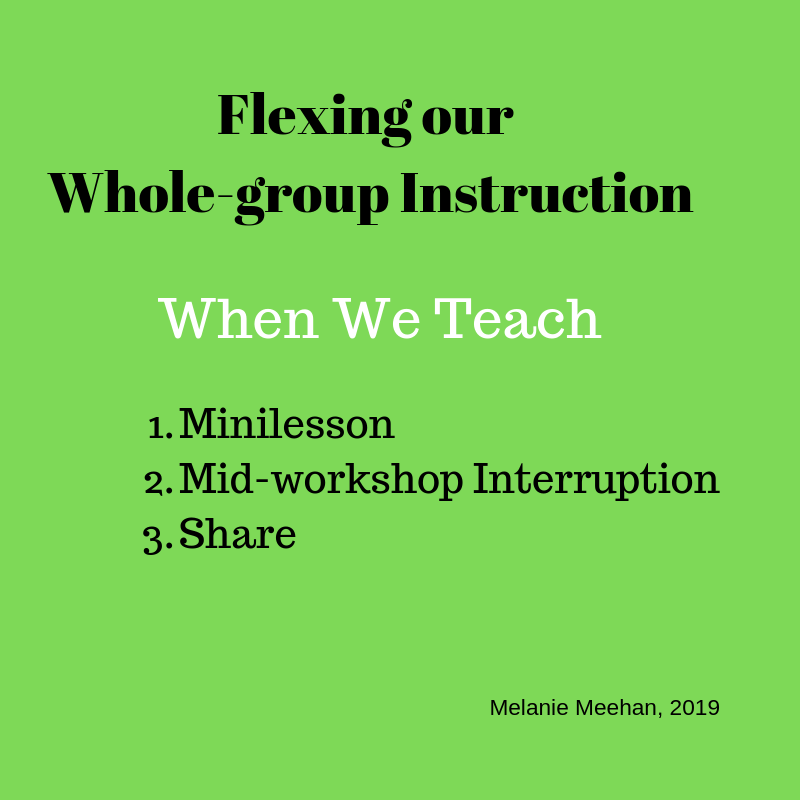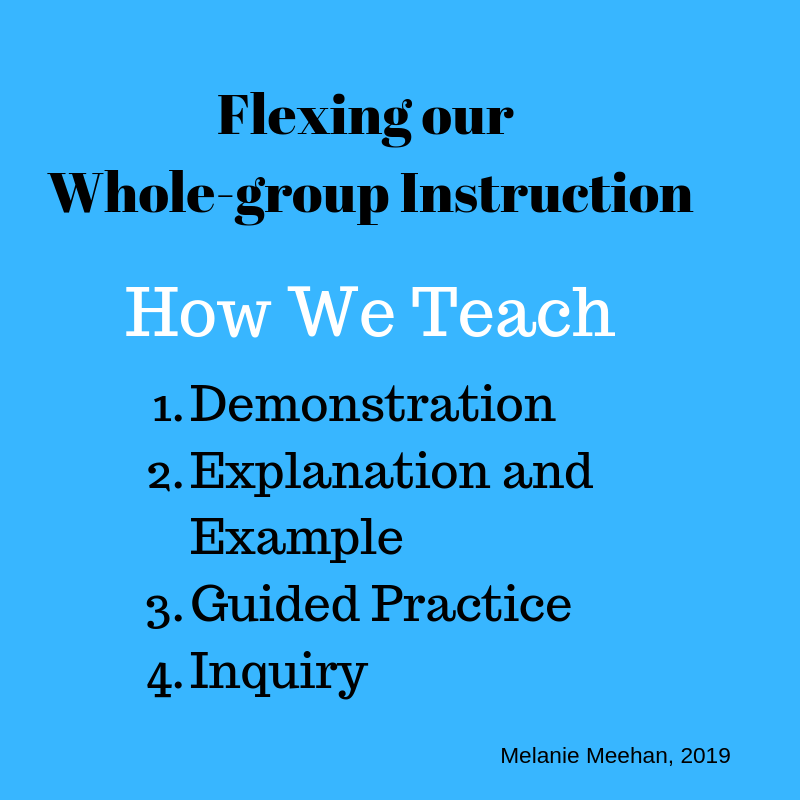One of my favorite lessons to teach during a narrative writing unit involves what stories are really about. Usually I teach this lesson as a whole group minilesson, but last week, I found myself teaching it as a whole group mid-workshop interruption, not even because it was planned, but because the whole class needed that lesson at that moment in time.
Back in August, I wrote a post about the importance of repertoire for students; repertoire is also important for teachers. We can change up how we are teaching depending on the situation and circumstances, but in order to do that, we have to know some choices and moves we can make. Knowing this, there are a few quick ways we can think about repertoire within our whole group instruction.
- When we teach

It can be easy to forget or overlook the idea that we have a few options for whole group instruction during a minilesson.
Minilesson: Typically, we think about the lesson’s objective as being part of the presentation within the minilesson at the beginning of the lesson, and most of the time it is. However, minilessons do not necessarily have to come at the beginning. Maybe you have students who come in late, maybe students benefit from settling into writing. Maybe you want them to practice more of what you’ve already taught. For any of these situations, you can change up the timing of your minilesson, offering independent writing time at the beginning of the workshop. I don’t recommend doing this regularly, but it is an option.
Mid-workshop Interruption: In many workshops, twenty minutes is a long time for students to sustain writing stamina. Therefore, another opportunity for instruction is in the middle of workshop. This can be a planned and intentional teaching point, or it can be a reminder or response to some of the work you’re seeing happening right then and there. This teaching opportunity doesn’t follow the components of the minilesson with a connection, teach, active engagement, and link, but you can consider it as having a teaching point and a link. You can say something along the lines of: “Here’s a quick reminder/tip/challenge I want to offer you right now… Here’s what it could look like… Consider working it into your writing.”
End of workshop share: Many teachers think of the end of workshop share as a time when students talk about their work during their independent writing time, and there is value in those shares and conversations. However, this can also be a time for intentional instruction. Maybe a student tried something many of their classmates are ready for. Maybe there’s another strategy that goes along with other learning of the day. In either case, you can use the end of workshop to teach something new and challenge students to try it on the following day.
2. How we teach

Just as we can think about the different moments in our writing workshops for instruction, we can also think about the different ways we can present information to students in a whole class format. At the Graphic Novel Writing Institute at Teachers College in April 2019, Eric Hand did a great job of presenting four different and explicit methods of delivering whole group instruction.
Demonstration: Demonstration is the technique I use the most when I’m teaching a minilesson. I ask students to watch as I use a strategy, voicing over as I demonstrate, and then I give them a turn to try it.
Explanation and Example is slightly different because it involves showing students samples of what you’re teaching, as opposed to creating those samples in front of them. Instead of cueing students to “watch as I try” you’re pointing out that “I tried that here.”
Guided Practice combines teaching and active engagement. While in the first two techniques there needs to be a time for students to try out the concept, even if it’s for a short turn and talk, guided practice challenges students to envision what the skill could look like and then have a try at it.
Inquiry is my second go-to technique behind demonstration, and it involves challenging students to explore a question. For example, we might ask a group “What are some ways to hook readers?” or “How can writers bring characters to life?” The important thing to remember if you’re using inquiry is that students have to have somewhat of a clue for it to be effective. If they have no idea how to answer the question, then you have to be ready to shift quickly back to demonstration or explanation and example.
Just as we ask students to stretch and try different techniques, we can challenge ourselves as teachers to expand our repertoire. It’s also helpful for our own clarity to know not only what we’re teaching, but also when and how we’re going to teach it. Flexibility is a great attribute in so many elements of life!
Discover more from TWO WRITING TEACHERS
Subscribe to get the latest posts sent to your email.

